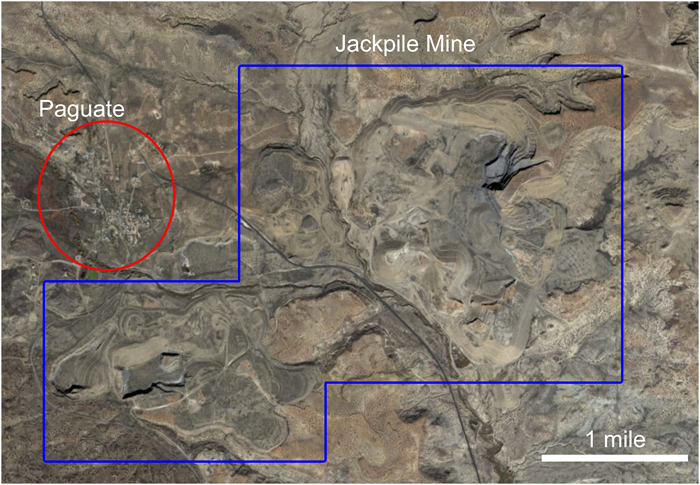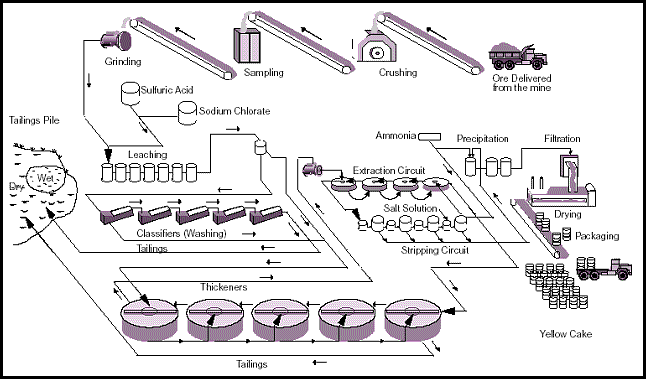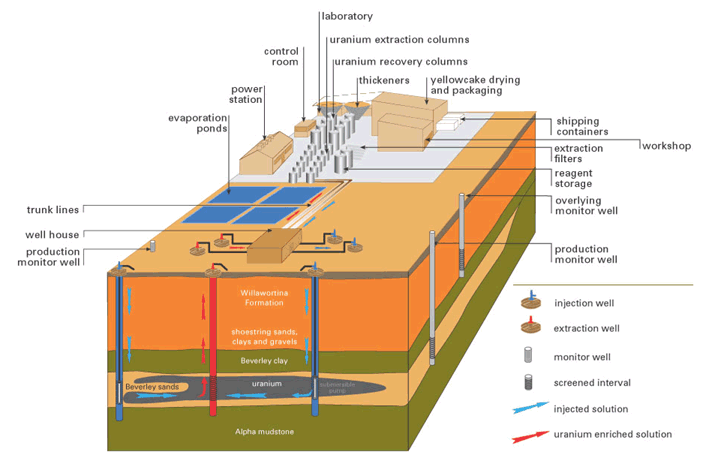
Uranium — How Is It Mined?
Uranium resources can be extracted from the ground in three ways: open pit, underground, and in-situ leach (ISL).
Open Pit Mining
Open pit mining, also known as strip mining, is the removal of surficial soils and uneconomic rock to get at the ore below. Ore grades are normally less than 0.5%. This is type of mining is only possible if the uranium ore is near the surface (normally less than 400 ft). The Jackpile Mine on Laguna Pueblo was once the world's largest open pit uranium mine.

Waste rock or overburden (the material removed over the ore body) usually is stored near the open pit. Once the ore horizon is exposed, a series of benches or steps are cut into it to make removal of the ore easier. Within the pit, depending on the size of the mine, there maybe one or more roads cut into the sides for the huge earth/ore haulers to navigate the area. Pumps maybe utilized to dewater the pit.

Source: Saskatchewan
Schools
Positives
- Less expensive than underground mining.
- Better ventilation (open-air).
- New mines must follow much stricter environmental, safety and health guidelines than were in place during the last uranium boom. For example a new open pit would require a mine and reclamation plan with phased mining, backfill, and then final reclamation to minimize the dimensions of the footprint on the landscape. Bonding is required on the front end to assure all of reclaimation and safety costs will be covered. Tailings piles have to be built to completely different standards than the past with lower subgrades, synthetic liners, leak detection wells, and 40 acres maximum size. Dust control is required on new operations, and radon will be subject to strict MSHA working level requirements.
Negatives
- HUGE footprint
- Waste rock piles can be enormous.
- Waste rock may be uneconomic to effectively mine, but once exposed to the atmosphere, they become hazardous to the environment
- Remediation is extremely costly and time consuming. Groundwater restoration can be extremely costly.
- Mine workers’ health can be compromised due to dust and radon exposure. Nearby communities can suffer negative health impacts due to the dust, noise and other issues (drainage ponds breaking).
Underground Mining
Underground mining is used to get at higher concentrations of uranium that are too deep to get at from open-pit. The ore is drilled, then blasted to create debris which is then transported to the surface, then on to a mill.
Positives
- Has a smaller surface footprint.
- Less waste rock.
- Advances in mining technology and safety monitoring makes many of the radiation/health issues associated with previous mining unlikely. These include better ventilation systems, possible robotic mining, and monitoring badges to make sure workers do not exceed the allowable radiation dosages.
Negatives
- Expensive.
- Potential to seriously impact local aquifers and expensive to remediate.
- In old underground mines, dust, radon and diesel fumes were a serious threat to miners’ health because of poor ventilation.
Milling
For both traditional underground and open pit mining, the rocks may have only a few percent (normally <0.3%) uranium in them. The uranium then has to be removed from the rock and concentrated. The milling process involves crushing and pulverizing the rock into very fine fragments and adding water to create a slurry. This slurry is then mixed with sulfuric acid or an alkaline solution to release the uranium from the host rock. Normally approximately 95 - 98% of the uranium can be recovered from the host rock. From this acid or alkaline solution, uranium oxide or yellowcake is precipitated. This is still not the purest form, and the uranium has to be sent to another plant to enrich it. The remaining rock slurry is pumped to a tailings dam. These tailings are exposed to the surface and heavy metals can be released into the environment.

Positives
- Only effective method to extract uranium from conventionally mined ores.
- Modern mills have more stringent laws governing their operation than old mills.
Negatives
- Tailings are exposed to the environment and any remaining uranium or heavy metals can be released.
- Very expensive to remediate.
- Formerly placed on porous units to help remove the water from the tailings slurry. Potential for severe impairment of local groundwaters.
In-situ Recover (ISR) Mining (also known as In-situ Leach or ISL)
While not all uranium ore deposits are amendable to ISR, it is the preferred method to extract uranium since it is far cheaper to get the ores out of the ground and it is considered more environmentally friendly than traditional underground or open pit mines.
In the United States, ISR involves:
- pumping water from the formation and adding oxidant such as gaseous oxygen. For some units, a carbonate phase such as sodium bicarbonate (baking soda) is added to the solution to make it easier for uranium to go into solution. Ideally, the pH of the solution is somewhere between 6.5 - 7.0 (close to neutral). This solution oxidizes the uranium in porous sandstones and make it easier to go into solution.
- the oxygen-rich solution is pumped down injection wells within a wellfield pattern,
- the solution moves through the rock dissolving the uranium in the ground,
- wells at prescribed distance from the injection wells pump uranium-enriched
waters to the surface,
- These wells pump more fluid than is put down the hole to create a "cone of depression,"
- This is to minimize the chance of off-site migration of these uranium- and mineral-enriched waters,
- There are monitoring wells surrounding these wells to check on break through of uranium- and mineral-enriched waters,
- these waters are treated and filtered to remove the uranium, and
- the treated waters are refreshed with oxidant and cabonates (if needed) and sent back down hole to start the process again.
- after uranium has been depleted to its economic limits, regulations require ISR operations in the United States to be restored to prescribed standards to try to assure that potable sources of water are not impacted.

Elsewhere in the world, like Australia and Kazakhstan, sulfuric acid is used, and remediation has not been required. This is not an acceptable technology in the U.S., and U.S. reclamation requirements would make it technically and economically impossible to allow sulfuric acid (or ammonia bicarbonate) systems here.
In the USA, alkaline solutions are the preferred, and sulfuric acid and peroxide solutions are used at ISL operations in Australia. The New Mexico Bureau of Geology and Mineral Resources has produced a article on the next uranium boom and ISL.
The positives of ISR are
- small surface footprint,
- very little waste rock (created in drilling the wells),
- inexpensive startup,
- less expensive to remediate than traditional mining and milling operations,
- less radiation exposure for the workers, and
- smaller, higher trained workforce.
The negatives of ISR are
- possible local contamination of aquifers (though in the US, solutions are usually near neutral),
- waters have to be pumped and monitored, even after active extraction has stopped, and
- waste water disposal and the public fears.
Links to more information
Any mention or link regarding a product, organization, company, or trade name is for information only and does not imply endorsement by the Bureau, NMT, or the State of New Mexico (see more).
- Underground Mining:
- In-situ Leach (ISL) Mining:
- Other Mining Sites:
- Wikipedia - Uranium Mining
- Wikipedia - U Mining in Kakadu
- Wikipedia - Mines
- WNA
- WNA-World U Mining
- WNA-U Mining in Canada
- Mining Legislation-Wise Uranium Project
- Global Infomine
- Seawater Uranium
- ANAWA-Problems with Mining
- Cameco
- EIA-US Uranium Mines
- Mining.com
- MiningNews.net
- EPA RadTown
- I Think Mining
- Wyoming Mining Association


